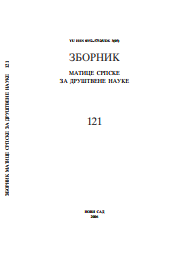БРАЧНОСТ СТАНОВНИШТВА ВОЈВОДИНЕ НА ПОЧЕТКУ ТРЕЋЕГ МИЛЕНИЈУМА
MARITAL STATUS OF THE POPULATION OF VOJVODINA AT THE BEGINNING OF THE THIRD MILLENNIUM
Author(s): Mirjana V. BobićSubject(s): Geography, Regional studies, Recent History (1900 till today), Family and social welfare, Demography and human biology
Published by: Матица српска
Keywords: marital structure; celibate; divorce; "Second demographic transition"; Vojvodina; Europe;
Summary/Abstract: The topic of this contribution is marital structure of the population of Vojvodina, based on the data from the last census from 2002. Due to the limited space, the analysis is reduced just to the basic indicators of marital structure: the distribution of the population according to the marital status, average age of the population when forming or dissolving unions, celibacy and divorced condition, while the processes of nuptiality and divorce rate, as the dynamic factors in the shaping of the structure, had to be left out. In short, the paper advocates the thesis about the blocked second demographic transition in Vojvodina. On the eve of the new millennium, a demographic trend occurring in Vojvodina began in the developed European regions at the end of the1960s, that is in the 1990s in case of Central and Eastern Europe. The basic features of that demographic regime were the decline of marriage universality, postponement of the formation of unions for later years, increase of different life-styles in pairs outside classic marriage, increase in divorce and general instability of unions, increase of celibacy and giving birth outside marriage, increase in gender equality in the private and public sphere, with further decrease in fertility to very low levels and acceleration of the processes of population ageing. In that respect, Vojvodina – as well as Central Serbia – lag behind the developed states of North-West Europe, but also the states in the postsocialist transformation. Modernization of marriage, its deinstitutionalization, liberation from the traditional value system, ideological changes which were registered in Vojvodina in 1980s, were discontinued because of the eruption of events on the global social plane, which slowed down the approach of this part of West Balkans to a broader, European environment.
Journal: Зборник Матице српске за друштвене науке
- Issue Year: 2006
- Issue No: 121
- Page Range: 313-323
- Page Count: 11
- Language: Serbian

